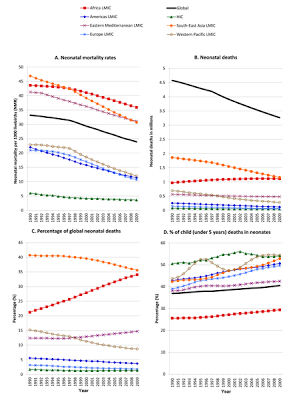Neonatal mortality — deaths in newborns, aged 3 weeks and under — has declined in all regions of the world over the past two decades but in 2009, more than half of all neonatal deaths occurred in five countries—India, Nigeria, Pakistan, China, and the Democratic Republic of Congo. Furthermore, over the past 20 years, more than 4% of all babies born live in India died during the first month of life. Historically, the main focus of studies of childhood mortality has been the infant and under-five mortality rates. Neonatal mortality (deaths under 28 days of age) has received limited attention, although such deaths account for about 41% of all child deaths.
As the risk of children dying before the age of five has fallen, the proportion of child deaths that occur in the neonatal period has increased. This increase is primarily a consequence of decreasing non-neonatal mortality in children under five from infectious diseases such as measles, pneumonia, diarrhea, malaria, and AIDS. Globally, 41% of under-five deaths now occur in the neonatal period.
In 2009, an estimated 3.3 million babies died in the first month of life—compared with 4.6 million neonatal deaths in 1990—and more than half of all neonatal deaths occurred in five countries of the world (44% of global livebirths): India 27.8% (19.6% of global livebirths), Nigeria 7.2% (4.5%), Pakistan 6.9% (4.0%), China 6.4% (13.4%), and Democratic Republic of the Congo 4.6% (2.1%). Between 1990 and 2009, the global NMR declined by 28% from 33.2 deaths per 1,000 livebirths to 23.9.
Background
Every year, more than 8 million children die before their fifth birthday. Most of these deaths occur in developing countries and most are caused by preventable or treatable diseases. In 2000, world leaders set a target of reducing child mortality to one-third of its 1990 level by 2015 as Millennium Development Goal 4 (MDG4). This goal, together with seven others, is designed to help improve the social, economic, and health conditions in the world’s poorest countries. In recent years, progress towards reducing child mortality has accelerated but remains insufficient to achieve MDG4. In particular, progress towards reducing neonatal deaths—deaths during the first 28 days of life—has been slow and neonatal deaths now account for a greater proportion of global child deaths than in 1990. Currently, nearly 41% of all deaths among children under the age of 5 years occur during the neonatal period. The major causes of neonatal deaths are complications of preterm delivery, breathing problems during or after delivery (birth asphyxia), and infections of the blood (sepsis) and lungs (pneumonia). Simple interventions such as improved hygiene at birth and advice on breastfeeding can substantially reduce neonatal deaths.
Why Was This Study Done?
If MDG4 is to be met, more must be done to prevent deaths among newborn babies. To improve survival rates and to monitor the effects of public-health interventions in this vulnerable group, accurate, up-to-date estimates of national neonatal mortality rates (NMRs, the number of neonatal deaths per 1,000 live births) are essential. Although infant (under-one) and under-five mortality rates are estimated annually for individual countries by the United Nations Interagency Group for Child Mortality Estimation, annual NMR trend estimates have not been produced before. In many developed countries, child mortality rates can be calculated directly from vital civil registration data—records of all births and deaths. But many developing countries lack vital registration systems and child mortality has to be estimated using data collected in household surveys such as the Demographic and Health Surveys (a project that helps developing countries collect data on health and population trends). In this study, the researchers estimate annual national NMRs and numbers of neonatal deaths for the past 20 years using the available data.
Up to 3.6 million lives could be saved every year if midwifery services were upgraded in 58 developing countries by 2015, according to a major new report released by the United Nations Population Fund (UNFPA), in partnership with the University of Southampton and 28 other organisations worldwide.
Around 950,000 newborns per year die from infection, according to the World Health Organization (WHO). Research conducted by PATH in Nepal and Tanzania suggests that many of these infections can be avoided when clean delivery kits are used.
If you liked this article, please give it a quick review on ycombinator or StumbleUpon. Thanks

Brian Wang is a Futurist Thought Leader and a popular Science blogger with 1 million readers per month. His blog Nextbigfuture.com is ranked #1 Science News Blog. It covers many disruptive technology and trends including Space, Robotics, Artificial Intelligence, Medicine, Anti-aging Biotechnology, and Nanotechnology.
Known for identifying cutting edge technologies, he is currently a Co-Founder of a startup and fundraiser for high potential early-stage companies. He is the Head of Research for Allocations for deep technology investments and an Angel Investor at Space Angels.
A frequent speaker at corporations, he has been a TEDx speaker, a Singularity University speaker and guest at numerous interviews for radio and podcasts. He is open to public speaking and advising engagements.



